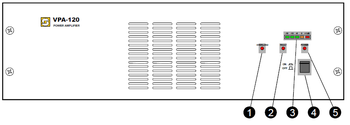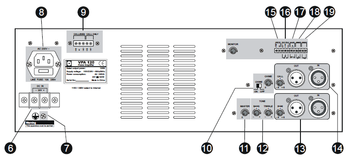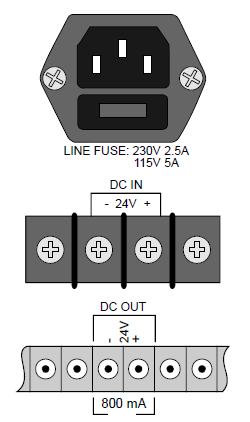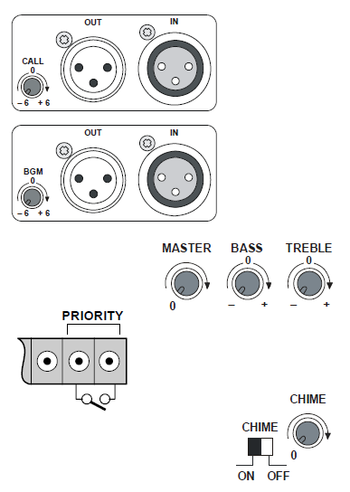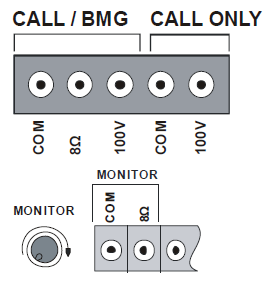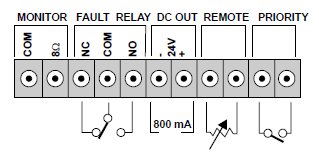VPA - Public Address Amplifiers: Difference between revisions
From Zenitel Wiki
| Line 88: | Line 88: | ||
[[Image:VPA-120-4.PNG|thumb|350px]] | [[Image:VPA-120-4.PNG|thumb|350px]] | ||
There are two inputs with 3-pin XLR connectors: | There are two inputs with 3-pin XLR connectors: | ||
:* Entertainment (BGM) for background music etc. with separate preset input level control. | :* '''Entertainment''' (BGM) for background music etc. with separate preset input level control. | ||
:* Call / alarm input for announcements and alarm messages with separate preset input level control. | :* '''Call / alarm''' input for announcements and alarm messages with separate preset input level control. | ||
Both inputs are connected in parallel with signal outputs to slave amplifiers or recorders.<br/> | Both inputs are connected in parallel with signal outputs to slave amplifiers or recorders.<br/> | ||
There are common master tone- and volume controls for both inputs. In addition, the volume may be controlled remotely by an external potentiometer.<br/> | There are common master tone- and volume controls for both inputs. In addition, the volume may be controlled remotely by an external potentiometer.<br/> | ||
Revision as of 15:02, 28 November 2008
INTRODUCTION
About this document
This manual is intended to give relevant information on the system
features, available equipment, typical configurations, simplified wiring
and programming and technical data for the concept.
This document is aimed at:
- Consultans
- Installers
- End users
Equipment covered by this document
Public adress amplifiers:
- VPA-120 (120 W)
- VPA-240 (240 W)
- VPA-400 (400 W (*1))
Note! The amplifiers are delivered for 230 VAC as standard. For 115 VAC mains, a plug must be removed and fuses must be changed. See section 3.3.4.
Rules and regulations
The VPA system and its components have been tested according to the following regulations:
- EN 60065: 2002
- “Audio, video and similar electronic apparatus. Safety requirements”
- IEC 60533: Second edition, 1999
- "Electrical and electronic installation in ships - Electromagnetic compatibility".
- EN 60945: Fourth edition, 2002
- "Maritime navigation and radio communication equipment and systems - General requirements - Methods of testing and required test results".
- IACS E10: Corr.1 July 2003
- "Unified environmental test specifications - Testing procedure for electric control and monitoring, safety and protection, onboard computer based systems and peripherals, loading instruments, internal communication and other electrical equipment as considered appropriate".
Publication log
v.1.0 - Sep. 2007
CONNECTORS AND CONTROLS
The connectors and controls of all three amplifier types are identical except for the maximum rated output power.
1 - Overload warning 2 - Fault warning 3 - VU-meter, -18, -10, -6, 0, +1dB 4 - Mains switch 5 - Power-on lamp 6 – 24 VDC backup power 7 – Frame ground connection 8 – Mains power connector and fuse 9 – Loudspeaker connections 10 – Pre-warning chime signal control 11 – Master volume control 12 – Master tone controls 13 – Entertainment input and output with volume preset 14 – Call/alarm audio input and output with volume preset 15 – 8 ohm monitor loudspeaker output with volume control 16 – no/nc relay for amplifier fault warning 17 – 24 VDC 800 mA power to external equipment 18 – Remote volume control 19 – Priority over entertainment input
Cabinet
The amplifier is prepared for mounting in a standard 19” rack and will occupy 3HU (133 mm) in height. The amplifier can also be free-standing on a level, open surface. Each amplifier has a built-in cooling fan, the front and back must be kept free of objects in order to secure sufficient air flow.
Power
The amplifiers are powered from 230 or 115 VAC mains, or 24 VDC.
The mains voltage is set inside the amplifier (default setting is 230 V). There is a mains circuit breaker on the cabinet front, and a mains fuse in conjunction with the mains inlet. The fuse value depends on the amplifier type.
24 VDC can be used as a backup source in case of mains power failure. The 24 V backup is not turned off by the mains switch or interrupted in
case of a blown mains fuse.
If an accumulator is used as 24 V backup, it will not be charged from the amplifier.
24 VDC/800 mA is available from the amplifier for external equipment.
The amplifier must be grounded either through the earth leg in the mains plug or by a 1.5 mm wire between the amplifier’s ground terminal and proven good grounding point, e.g. the rack frame.
Signal inputs
There are two inputs with 3-pin XLR connectors:
- Entertainment (BGM) for background music etc. with separate preset input level control.
- Call / alarm input for announcements and alarm messages with separate preset input level control.
Both inputs are connected in parallel with signal outputs to slave amplifiers or recorders.
There are common master tone- and volume controls for both inputs. In addition, the volume may be controlled remotely by an external potentiometer.
A call input signal will automatically mute the BGM entertainment source (VOX function). This can also be achieved manually by connecting the microphone switch to the priority terminals.
A pre-warning chime signal can be given in front of a message when a priority switch is pushed. This feature can be switched on/off and the chime loudness can be adjusted.
Loudspeaker outputs
There are three loudspeaker outputs:
- Call and Background Music (BMG), full power output available on an 8 Ohm terminal as well as on a 100 V constant voltage line.
- Call only, full power output on a 100 V constant voltage line. This terminal carries no background music.
- Monitor Loudspeaker, 1 W power output to an 8 Ohm loudspeaker, normally mounted close to the amplifier to monitor entertainment and call channels. The output has a separate volume control.
Optional connections
- Fault Relay, NO/NC contacts of a built-in relay is available for remote warning devices. The relay is activated during fault conditions such as mains power failure or open or shorted speaker lines.
- DC Out, 24 VDC/800 mA is available for optional equipment.
- Remote, connection of remote master volume control. A logaritmic 22 kOhm potmeter is suitable.
- Priority, by pushing a button on the microphone, a chime signal is manually activated in front of a message.

